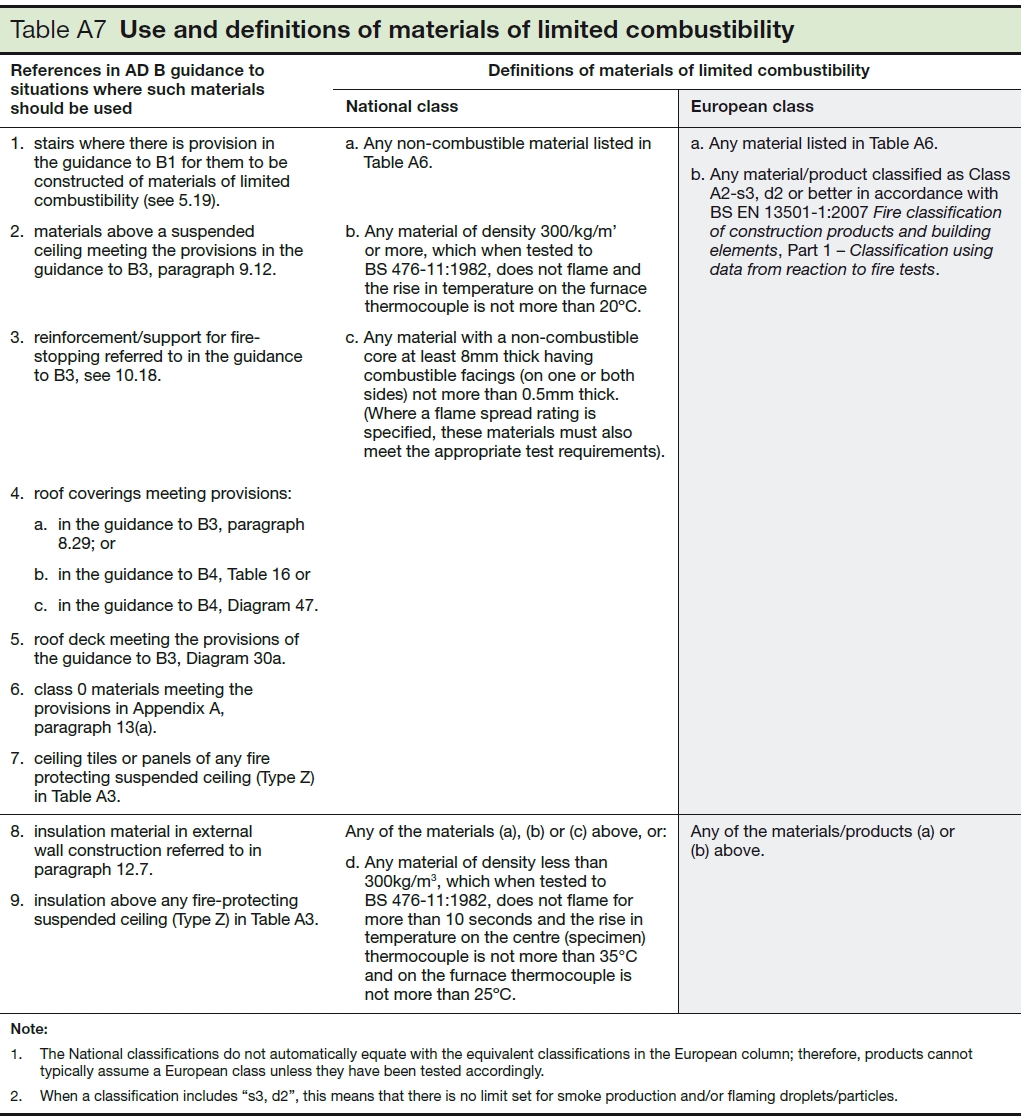Material of limited combustibility
Approved document B of the building regulations 'Fire Safety', defines limited combustibility as:
| A material performance specification that includes non-combustible materials, and for which the relevant test criteria are set out in Appendix A, paragraph 9. |
Paragraph 9 states :
|
Materials of limited combustibility are defined in Table A7: a. (National classes) by reference to the method specified in BS476: Part 11:1982; or b. (European classes) in terms of performance When classified as class A2-S3, d2 in accordance with BS EN 13501-1:2007, Fire classification of construction products and building elements, Part 1 - Classification using data from reaction to fire tests when tested to BS EN ISO 1182:2002, Reaction to fire tests for building products - Noncombustibility test or BS EN ISO 1716:2002 Reaction to fire tests for building products - Determination of the gross calorific value and BS EN 13823:2002, Reaction to fire tests for building products - Building products excluding floorings exposed to the thermal attack by a single burning item. Table A7 also includes composite products (such as plasterboard) which are considered acceptable and where these are exposed as linings they should also meet any appropriate flame spread rating. |
Table A7 is shown below:
PAS 9980:2022, Fire risk appraisal of external wall construction and cladding of existing blocks of flats – Code of practice, published by BSI Standards Limited in 2022, defines a material of limited combustibility as either:
- a) a noncombustible material or product; or
- b) any material or homogenous product of density 300 kg/m3 or more, which, when tested in accordance with BS 47611, does not flame and the rise in temperature on the furnace thermocouple is not more than 20 °C; or
- c) any product with a noncombustible core of 8 mm thick or more, having combustible facings (on one or both sides) not more than 0.5 mm thick; or
- d) a material or product classified as Class A2s3, d2 in accordance with BS EN 135011:2018, when tested in accordance with BS EN ISO 1182 or BS EN ISO 1716 and BS EN 13823
NOTE This term is included here given its use in relation to materials used in, and standards applicable to, existing buildings. It is derived from guidance in previous versions of ADB ([10], [11], [12], [13], [14]), but this term is no longer in use in the current version of ADB ([8], [9]).
[edit] Related articles on Designing Buildings
- ACM cladding.
- Approved document B.
- BS EN 13501-1.
- External fire spread, Supplementary guidance to BR 187 incorporating probabilistic and time-based approaches.
- External fire spread: building separation and boundary distances (BR 187).
- Fire and rescue service.
- Fire authority.
- Fire door.
- Fire in buildings.
- Fire performance of external thermal insulation for walls of multistorey buildings, third edition (BR 135).
- Fire protection engineering.
- Fire resistance.
- Fire retardant.
- Fire safety design.
- Firefighting route.
- Flame retardant.
- Flammable.
- Grenfell Tower fire.
- Joint fire code.
- Protected escape route.
- Managing risks in existing buildings: An overview of UK risk-based legislation for commercial and industrial premises (FB 86).
- The Regulatory Reform (Fire Safety) Order 2005.
- The role of codes, standards and approvals in delivering fire safety.
Quick links
[edit] Legislation and standards
Fire Safety (England) Regulations 2022
Regulatory Reform (Fire Safety) Order 2005
Secondary legislation linked to the Building Safety Act
Building safety in Northern Ireland
[edit] Dutyholders and competencies
BSI Built Environment Competence Standards
Competence standards (PAS 8671, 8672, 8673)
Industry Competence Steering Group
[edit] Regulators
National Regulator of Construction Products
[edit] Fire safety
Independent Grenfell Tower Inquiry
[edit] Other pages
Building Safety Wiki is brought to you courtesy of:





